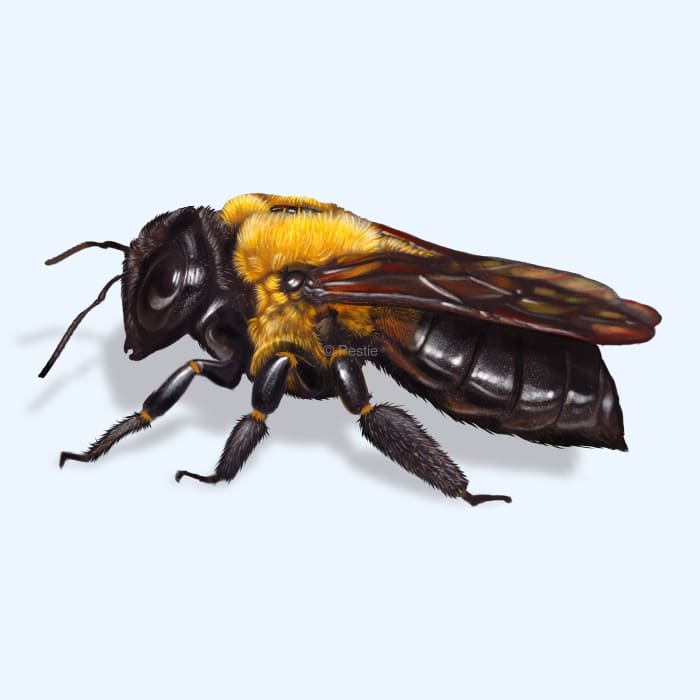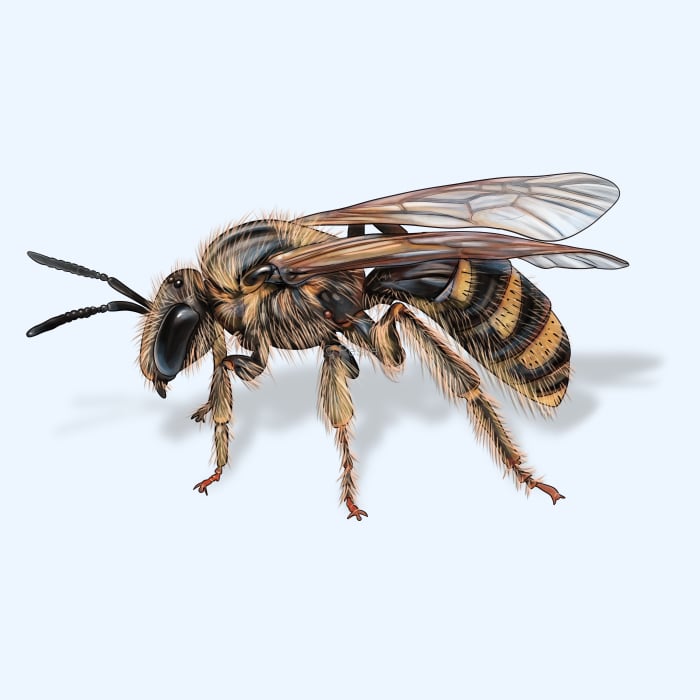Identifying and understanding bees
Preventing your home from becoming their hive
Bees can either be your best friends or your worst nightmare. It depends on whether they want to pollinate your flowers or make your home their new hive.
When we talk about bees, most people think about honey bees. However, several bee species, including bumblebees and carpenter bees, can cause problems for homeowners.
Honey bees are a tricky pest to deal with, especially if the entire colony decides to move into a portion of your property. However, bees are important pollinators that help all kinds of fruits and vegetables grow, creating products like honey and beeswax.
Bumblebees make their nests in the ground, and while not particularly aggressive, it can be a little unnerving to have bumblebees dive bombing you every time you pass their unseen nest somewhere in your yard.
Carpenter bees are large bees that look similar to bumblebees, but they make their nests in the wooden structures of your home. Look for large holes in wood structures on your porch or deck.
How to identify bees
- Honey bees – These bees are smaller than bumble bees and carpenter bees. They have the iconic black and yellow striping on their abdomen and sometimes have lumps of pollen on their legs.
- Bumblebees – These bees are large and fuzzy all over their body. Depending on the species, they will have black and yellow striping and sometimes a bit of orange.
- Carpenter bees – While similar to bumblebees at first glance, carpenter bees have a smooth, solid black abdomen.
Bee sting self-care and treatment
When you first get stung by a bee, staying calm is essential. Make sure to walk away from the area where you were stung. You may be near a nest or hive that you can’t see.
Next, examine the sting and see if a stinger is still in the skin. Honey bee stingers are barbed and will rip out of their bodies, leaving a venom sack still pumping venom into your body. It’s best to scrape the stinger out of your skin instead of trying to pull it out. If you squeeze the venom sack, you will inadvertently push more venom into your skin.
Once you’ve determined the stinger is out, wash the sting with soap and water and add an ice pack to reduce the swelling.
You may consider also taking an over-the-counter medication, like an anti-histamine or anti-inflammatory. You can also rub hydrocortisone cream on the sting to reduce the itch.
If you start to have an allergic reaction and it is causing your airway to constrict, contact medical help immediately.
Wasp vs bee
While their stings might feel the same, there are quite a few differences between bees and wasps. Bees are usually covered in fine hairs, while wasps appear shiny and hairless. Wasps usually have a thin “waist” that separates the thorax and abdomen. Bees lack this thin waist.
Wasps can make their nests in the ground or structures made from mud or a paper-like substance. Bees can make their nests in the ground, too, but honeybees will make their nests in the cavities of a tree or under large objects.
How to get rid of bees
If you’ve discovered bees in your yard, or worse, making a nest inside your home, then your first thought may be to spray them with some sort of insecticide. That is usually the wrong approach, as these beneficial insects aren’t trying to take over your property.
The right approach depends on the type of bee you are dealing with. If you see a large swarm of bees near your home, it’s best to leave them alone. Honey bee swarms are looking for a new place to live and are non-aggressive during this stage of their life. The swarm will probably move on after a few hours or a couple of days. If you are worried about them making a hive in and/or around your home, it’s best to call a professional beekeeper to remove them for you.
Bumblebees will make their nests in the ground and are only there for one year before the bees die and make a new hive somewhere else. You can either avoid the nests, fence the nests to avoid anyone contacting them, or contact a professional to relocate or remove the hive. If you wait until the hive dies in the autumn, then make sure to block the entrance, as other queens may reuse the nest.
Carpenter bees will drill holes in wood, like on your deck or porch, to lay their eggs. While the damage done is minor, extensive damage can occur over time after many generations nesting in the same area. You can either spray a pesticide, like Pestie, into the carpenter bee holes, use a foam spray designed for bees, or cap any holes you see in the wood with putty. You can also prevent bees from making new nests by coating all exposed wood with a paint, polyurethane, or oil-based finish.
If you find honey bees making a hive in the walls or attic of your home, then it’s best to call in a professional to help you remove the hive. This can be an extensive job that requires the right equipment and tools to remove them completely.
Treat bees with Pestie
If you're still having trouble keeping bees away, the best option is to use a pro-grade, effective pest control solution like Pestie.
Pestie is a do-it-yourself pest control solution that's specially designed to keep bees and other pests away from your home.
With Pestie, you can rest easy knowing that your living space is protected and free of creepy crawlies. And the best part? It's designed for people, pets, and the planet, so you can say goodbye to harsh chemicals and hello to peace of mind!
- Save hundreds compared to traditional annual pest plans
- People, pet, and planet-friendly
- Pro-grade customized formulas












